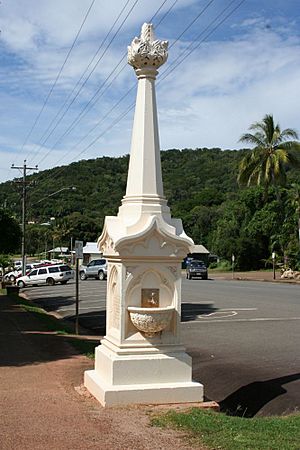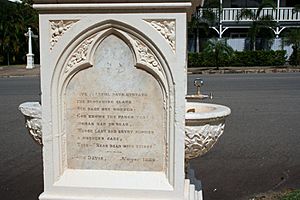Mary Watson's Monument facts for kids
Quick facts for kids Mary Watson's Monument |
|
|---|---|

Mary Watson's Monument, 2010
|
|
| Location | Charlotte Street, Cooktown, Shire of Cook, Queensland, Australia |
| Design period | 1870s - 1890s (late 19th century) |
| Built | 1886 |
| Architect | Ernest Greenway |
| Official name: Mary Watson's Monument | |
| Type | state heritage (built) |
| Designated | 21 October 1992 |
| Reference no. | 600421 |
| Significant period | 1886- (social) 1886 (historical, fabric) |
| Significant components | memorial - drinking fountain |
| Builders | Ernest Greenway |
| Lua error in Module:Location_map at line 420: attempt to index field 'wikibase' (a nil value). | |
The Mary Watson's Monument is a special memorial in Cooktown, Australia. It was built in 1886 by Ernest Greenway. This monument honors Mrs. Mary Watson, her baby son, and her Chinese employee, Ah Sam. They sadly died in 1881 while trying to escape danger on an island. The monument is listed on the Queensland Heritage Register because of its important history.
Contents
The Story of Mary Watson
This monument was put up in 1886 by the people of Cooktown. It remembers Mary Watson, her baby son, and her Chinese worker, Ah Sam. They died from thirst and heat on an island near Cooktown in October 1881.
Mary Watson's sad story touched many people in North Queensland. She was seen as a brave woman helping to settle new areas. Her youth, her fight to save her baby, and the diary she kept until the end made her story very moving.
Mary Oxnam came from England to Maryborough in 1877 when she was 17. She later became a governess and opened her own school in Cooktown. In May 1880, Mary (aged 20) married Captain Robert Watson. He ran a sea cucumber fishing station on Lizard Island, about 80 kilometers northeast of Cooktown.
After they married, the Watsons moved to Lizard Island. Robert had built a house and a smokehouse there. They also had a small garden. Two Chinese men, Ah Sam and Ah Leong, helped them. Mary returned to Cooktown in March 1881 to have her baby. She was back on Lizard Island with her son, Ferrier, by July.
The Tragedy on Lizard Island
On September 1, 1881, Robert Watson and his partner left Lizard Island. They went north to Night Island for about six weeks to set up another fishing spot. Mary was left on Lizard Island with her baby and the two Chinese workers.
On September 27, a group of Aboriginal people came to Lizard Island. The island was a sacred place for them. Mary's diary shows that they wanted the foreigners to leave. It is believed that on September 29, they attacked and killed Ah Leong, who was working in the garden. His body was never found.
On September 30, the group gathered near Mary's home. They left when Mary fired a rifle. But they returned on October 1 and badly hurt Ah Sam.
Mary feared another attack. She had no other way to escape. She quickly packed some things, food, water, and two paddles into a large iron tank. This tank was normally used for boiling sea cucumbers. On October 2, she, Ah Sam, and the baby set off in the tank.
By October 4, they reached a reef. They stayed there a day, hoping to see a ship. On October 6, they landed on Howick Island No. 1 to get fresh water. But Aboriginal people were camped there, so they moved to another reef. On October 7, they reached Howick Island No. 5. This island was on the steamer route, but it had no fresh water.
They were too weak to continue. They hoped a passing ship would see them, but none did. Mary kept a short diary during this terrible time. Her last entry was on October 11:
Still all alive. Ferrier [her child] very much better this morning. Self feeling very weak. I think it will rain to-day; clouds very heavy; winds not quite so hard. No rain. Morning weather fine. Ah Sam preparing to die. Have not seen him since 9. Ferrier more cheerful. Self not feeling at all well. Have not seen any boat of any description. No water. (Nearly dead with thirst.)
Their bodies were found by fishermen on January 19, 1882. Robert Watson identified them later. He had been searching for his family since November 1881.
Remembering Mary Watson
Mary Watson's bravery and sad story deeply affected people. On January 29, 1882, a large public funeral was held in Cooktown. About 650 people attended. Mary, her child, and Ah Sam were buried in the Cooktown Cemetery.
This tragedy made tensions worse between European settlers and Aboriginal people in the Cooktown area. A group of Aboriginal people were punished, but some historians believe it was the wrong group.
In 1885, people raised money to build a memorial for Mary Watson. The Cooktown Municipal Council helped. The monument, a drinking fountain, cost £165. It was unveiled in February 1886 by Mayor John Davis.
The monument was designed by Ernest Greenway, a stonemason from Ipswich. He won a competition for the design.
About the Monument
The Mary Watson's Monument is at the corner of Adelaide and Charlotte Streets in Cooktown. It stands on the footpath, near the Cook Shire Council Chambers.
The monument is made of painted concrete. It has a base and a tall, eight-sided spire. The name E Greenway and Ipswich are carved on the base. The base has decorative carvings of flowers.
There are working water fountains on the north and south sides. They have semi-circular bowls shaped like leaves. On the east and west sides, there are marble panels with inscriptions.
The inscription on the western panel is a poem:
Five fearful days beneath
the scorching glare
Her babe she nursed.
God knows the pangs
that woman had to bear,
Whose last sad entry showed
a mother's care'
Then - "Near dead with thirst".
John Davis Mayor 1886
The inscription on the eastern panel says:
IN MEMORIAM MRS WATSON,
The Heroine of Lizard Island
Cooktown North Queensland AD 1881
Erected 1886. Edward D'Arcy Mayor. 1885
The tall, eight-sided spire sits above the base. It ends with a decorative leaf design at the very top.
In recent years, the water pipes for the fountains have been repaired. This involved cutting into the concrete on the northern side. The repair can be seen as a narrow line down the monument.
Why It's Important
Mary Watson's Monument is listed on the Queensland Heritage Register because it's important for many reasons:
- It shows Queensland's history: The monument reminds us of the difficult times during early European settlement in Queensland. It also shows the lack of understanding between Aboriginal people and settlers during that period. The fact that the monument does not also honor Ah Sam, the Chinese man who died with Mary Watson, shows the different attitudes of society at that time.
- It's unique: It is believed to be the only public monument in Queensland dedicated to an individual woman (who was not a head of state).
- It's a good example of its kind: It's a great example of a late 19th-century public memorial. It served as both a drinking fountain and a way to remember someone.
- It's beautiful: The monument adds to the historic look of Charlotte Street, which is Cooktown's main street.
- It's important to the community: The people of Cooktown value this monument for its history. It is also a popular place for tourists to visit.
- It's connected to Mary Watson: The monument has a strong link to Mary Watson. It helps keep her story and the legends around her death alive.


